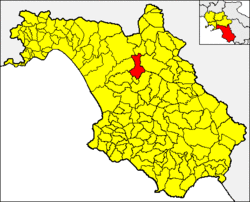Postiglione | |
|---|---|
| Comune di Postiglione | |
 The castle in town's center | |
 | |
| Coordinates: 40°34′N 15°14′E / 40.567°N 15.233°E | |
| Country | Italy |
| Region | Campania |
| Province | Salerno (SA) |
| Frazioni | Canneto, Lagorosso, Selvanera, Terzo di Mezzo, Aquara, Pescara |
| Area | |
| • Total | 47 km2 (18 sq mi) |
| Elevation | 605 m (1,985 ft) |
| Population (1 April 2009)[3] | |
| • Total | 2,312 |
| • Density | 49/km2 (130/sq mi) |
| Demonym | Postiglionesi |
| Time zone | UTC+1 (CET) |
| • Summer (DST) | UTC+2 (CEST) |
| Postal code | 84026 |
| Dialing code | 0828 |
| ISTAT code | 065101 |
| Patron saint | San Giorgio and San Nicola |
| Saint day | 23 April |
| Website | Official website |
Postiglione (Campanian: Pustiglione) is a town and comune in the province of Salerno in the Campania region of south-western Italy.
Geography
[edit]Located in Cilento, below the Alburni mountains, borders with the municipalities of Altavilla Silentina, Campagna, Castelcivita, Controne, Contursi Terme, Serre and Sicignano degli Alburni.
Postiglione counts 5 frazioni: Canneto, Duchessa, Selvanera, Terzo di Mezzo and Zancuso. Canneto, located on the road between Postiglione and Controne, is the most populated one.
References
[edit]- ^ "Superficie di Comuni Province e Regioni italiane al 9 ottobre 2011". Italian National Institute of Statistics. Retrieved 16 March 2019.
- ^ "Postiglione". Tuttitalia (in Italian).
- ^ All demographics and other statistics from the Italian statistical institute (Istat); Dati - Popolazione residente all'1/4/2009
External links
[edit]![]() Media related to Postiglione at Wikimedia Commons
Media related to Postiglione at Wikimedia Commons



Well, that’s interesting to know that Psilotum nudum are known as whisk ferns. Psilotum nudum is the commoner species of the two. While the P. flaccidum is a rare species and is found in the tropical islands. Both the species are usually epiphytic in habit and grow upon tree ferns. These species may also be terrestrial and grow in humus or in the crevices of the rocks.
View the detailed Guide of Psilotum nudum: Detailed Study Of Psilotum Nudum (Whisk Fern), Classification, Anatomy, Reproduction